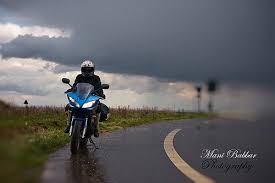
Rain changes everything because it creates:
- Wetness. That makes you uncomfortable.
- Slipperiness. That can drop the bike.
- Obscurity. That reduces visibility to see ahead.
Wetness, slipperiness and obscurity make rain dangerous for the unwary motorcyclist.
The rain prayer

I often ride in the rain and so am not scared of it. If it rains, I go anyway. However before I ride in the rain, I say “the rain prayer”. It goes like this: “Let me take care out there!” Its also a sincere wish. You dont have to get on your knees or light a candle or anything. It only takes a second. The main thing is to put the thought in your head that rain changes everything! The problem is that habits die hard, so we tend to drive the same in the rain. You cant do that on a motorcycle. Most people see rain and worry about getting wet. If is warm, wet is no big deal, as we are all wet on the inside anyway. Getting wet doesnt hurt you at all. The big thing is: change your attitude when it rains. With that and wet-weather gear, rain is no problem.
Wetness
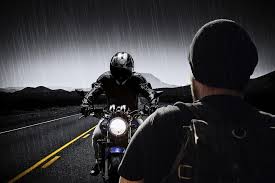
Rain soaks your clothes and makes you feel uncomfortable, and if it is cold doubly so. Wet gloves feel horrible and wet boots wrinkle your feet. When you arrive soaked, you feel a wreck and have to change clothes. For these reasons, riders want to travel through rain and arrive as they started – warm and dry. The answer is waterproof gear that sheds rain like water off a duck’s back.
Plug the gaps
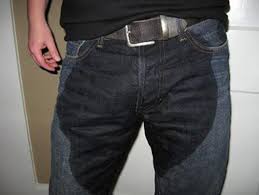
Water has a way of getting into places. At riding speeds, wind forces water into any gaps. While each thing you wear might be waterproof, their combination may not be. If you have a leak at one point, it will seep in and spread. You are as waterproof as your first leak. To keep dry, pay attention to the following gaps:
- Neck: A scarf stops water dribbling down your neck and back.
- Wrists: Gloves (gauntlets) should overlap your jacket sleeves.
- Waist: Make sure your jacket is long enough to cover your leggings in the riding position.
- Ankles: Leggings must be long enough to overlap your boots when crouched.
Very light raincoats

I always carry a very light raincoat or wind-breaker. It is so thin it can crush to the size of a fist and is easy to carry on a bike. It has two uses:
- Layering. Under your main jacket it is additional protection against water.
- Passengers. If you have a passenger, they can wear it for protection.
When riding, always carry a spare very light wind-breaker, whether waterproof or not.
Slipperiness
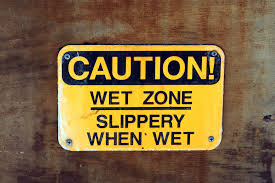
Rain increases road slipperiness so any safety practice you have, double it in the rain! This applies to cornering, stopping, speed and accelerating. You have only half the stopping power, so double your usual following distance. If you normally take a corner at a certain lean, lean a lot less in the rain. Wet roads also combine dangerously with other slip factors, like white lines and manhole covers.
The first wet

During a dry weather spell, oil from cars builds up on roads. When it rains, the water cleans the roads by loosening these dried up surface oils and in time washes them away. But if you are riding in the first rain after a dry spell, take special care as these oils are still on the surface. The first wet is the worst wet, as rain after a long dry period makes roads extra slippery. Until they wash clean, the roads are extra dangerous for motorcycles.
Reduced Visibility

The main problem with rain is that it obscures vision. Rain drops on the visor outside make it hard to see. You cant clear the drops with your gloves as they smear the visor and make it worse. Sometimes at riding speeds you can turn your head briefly so the wind flow blows the raindrops off. If not, maybe the drop pattern has a clear patch you can see through – altering your head position in the helmet may help. If not, you have to stop and clear. It is worse when rain gets inside the visor to give an inner drop layer as well as an outer one. When two overlapping layers of drops obscure your vision, you have to stop and clear. Don’t ride on, as riding blind is not an option!
Fogging
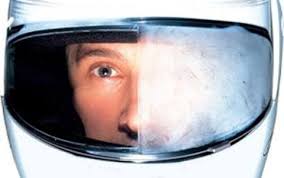
Fogging occurs when moist air condenses inside your visor. While raindrops partly obscure vision, fogging blocks it entirely. On a nice day you can lift your visor slightly to let the airflow clear the fog, but fogging is more common when it rains. Dealing with visor fogging in wet weather is my pick for worst riding problem. It is a catch-22 between visor down and fogging vs visor up slightly that gives water droplets inside the visor as well. If you wear glasses like I do, water drops on your spectacle lens mean three overlapping layers of droplets blocking vision. Thats bad! A fogging visor in the rain isn’t easy to deal with, but here are some options:
- Anti-fog liquid. Anti-fog liquid inside and outside your visor, and on your glasses if you wear them, reduces fogging and repels the rain. I always carry anti-fog for this reason.
- Visor vents open. Most visors have vents – check they are open in hot muggy weather.
- Lift visor slightly. Click your visor up a fraction, as even a little air flow can clear fogging. On a trip, over time rain drops will still get through, so stop periodically to clean the visor inside and out.
- Breathe down. Fogging often starts when you stop at traffic lights as there is no airflow. So while stopped I breathe out downwards to fog less, and might also temporarily raise the visor up a bit to get clearing air, then pop it down again when the light goes green.
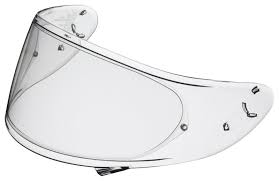
The best solution is a visor that is anti-fog to start with, or buying an anti-fog visor insert to fit inside the visor. Visor fogging is so dangerous that I always fit an anti-fog strip inside any helmet that I buy. You have to take the visor off to apply it, so it often pays to do it in the shop when you buy. They may help you fit the strip right and get the visor back on correctly afterwards.
Fog
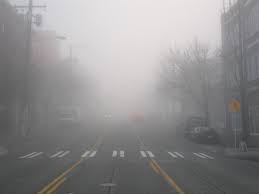
Fog is when droplets of water condense in the air around you to reduce vision. It is not common but fog happens, and when does visibility goes way down. There are stories of people being unable to see their hand held out in front of them in fog. Fog reduces your main line of defense – vision. And when your vision goes down, so must your speed. Speeds of 20 or 10 mph are not unreasonable in fog. Fog on a highway produces 50 car pile-ups when drivers ignore visibility conditions. On a motorcycle in bad conditions like fog, look for a “sweeper”, a large vehicle that can blaze a trail for you. Behind a big truck you can travel faster than your lights allow, as their lights see further.
Water-planing
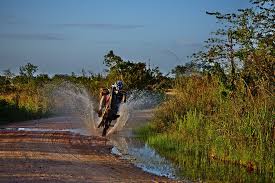
Sometimes a body of water several inches deep or more forms on the road that you must ride through. If you hit solid water at speed it becomes hard, and like a water-skier you skid across it. This is called water-planing. So as for cornering, enter slowly then accelerate to push through it. A motorcycle can move through quite deep water, deeper than most cars, but the key is once you enter don’t stop. Keep the revs up and use the clutch to give more power as needed. Move through at a steady pace without trying to force it. Water-planing happens when riders try to force their way through water. If you go through gently, the water simply moves aside for you.